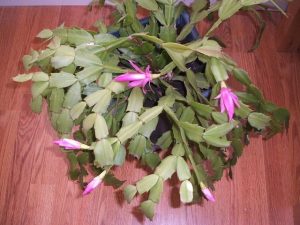Imagine this scenario. The room smells rich, of dark mahogany wood and comforting, overstuffed chairs. The silver-headed gentleman at the head of the table is talking in calm tones about the will and finances. The first item to discuss is the 48-year-old Christmas cactus, the funds to continue its wellbeing and the person responsible for its care.
A 48-year-old Christmas cactus is not unusual and is actually very young compared to the oldest living house plant. The Eastern Cape Cycad at the Conservatory at London’s Kew Garden has that designation. It weighs more than a ton and has lived in a pot since 1775, when it was brought to England by plant hunter Francis Masson from South Africa, strapped to the deck of a wooden sailing ship. It was re-potted in July 2009 by a team of nine determined caretakers and is thriving today.
If you are interested in long-lived houseplants, it is surprisingly easy to locate these potential heirloom plants. You may already have a few.
Christmas cactus is a famous native in a legend from Brazil. The legend says a poor little boy prayed for a sign of Christmas. He discovered the plain little plant in the hot, humid jungle. Days passed without a sign. One morning he awoke to every branch ending with a brightly colored flower, an answer to his prayers.
Jade plants, snake plants, weeping figs, rubber plants, Boston ferns, cacti and succulents, cast iron plants, and palms all have the ability to join the generational houseplant list. They have no pre-determined lifespan. Their lives are limited by the care and growing conditions they receive.
For your houseplant to survive to a ripe old age, it will need attention. The environment must be consistent and compatible to your plant of choice.
Houseplants have preferred locations, with adequate light but not scorching, burning sunlight. The perfect example is the Ficus benjamina or weeping fig. That plant will thrive in one spot but drop every leaf in another. In its happy place, it will live for decades.
Houseplants need to be watered in their pots but not stand with their feet in water for days. Houseplants like humidity. A misting, or in some cases a shower, will keep them healthy and happy.
The soil in the pot has a long-term effect on plant longevity. There will be times when, like the Eastern Cape Cycad mentioned above, repotting will bring benefits. New potting soil offers an expanded area for roots, improved nutrition, and better water-holding capabilities. Since potting soil does have a life expectancy it is best to purchase a good quality organic soil.
Longevity starts with good habits. These house plants and more can live “forever.” Pass your valuable heirloom plants on to the next generation. The plants will last longer than the inherited bank accounts. And, at least, you will leave everyone in that mahogany-wooded office surprised.
Julie Silva is a University of California Cooperative Extension Master Gardener of Tuolumne County.
University of California Cooperative Extension Master Gardeners can answer gardening questions. In Tuolumne County call (209) 533-2912 and in Calaveras County call (209) 754-2880. You can fill out our easy-to-use problem questionnaire here. Check out our website here. You can also find us on Facebook.

